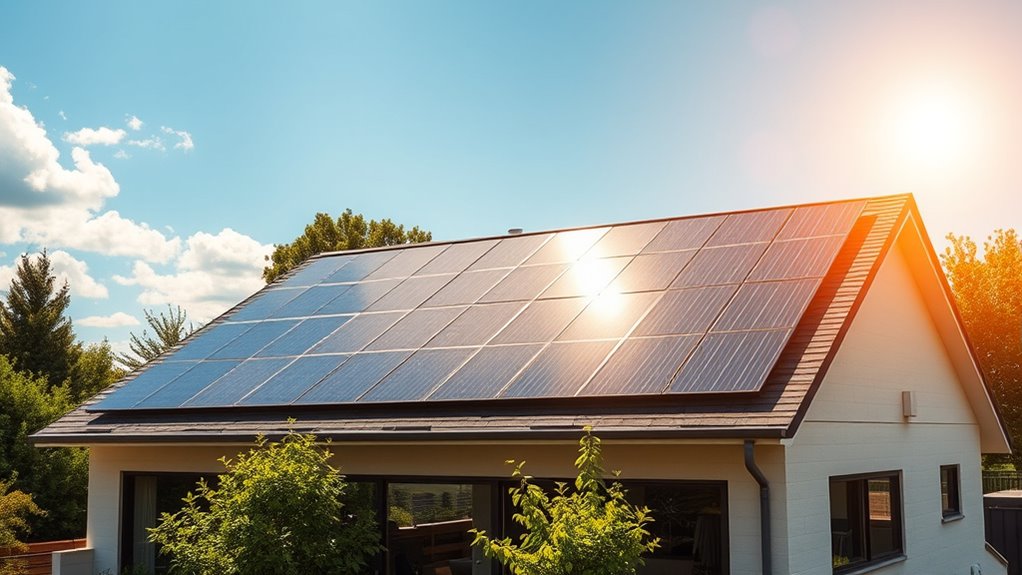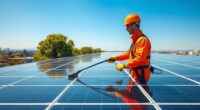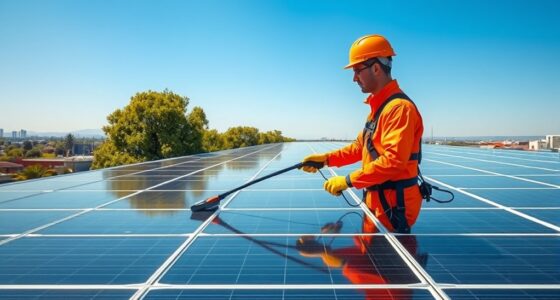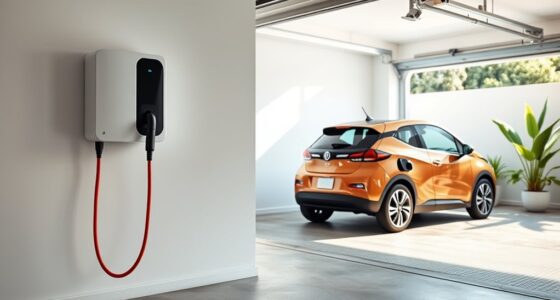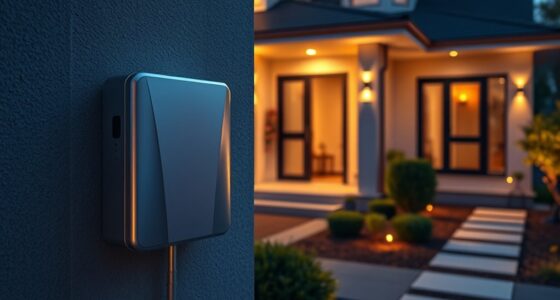Installing solar panels at home can save you thousands on electricity costs and boost your property value. You’ll reduce your carbon footprint and enjoy cleaner air, all while gaining energy independence through better storage options. Plus, government incentives make the switch more affordable. With advancements in technology, solar systems are more reliable and efficient than ever. Want to discover how these benefits can come together for your home? Keep exploring to find out more.
Key Takeaways
- Significant long-term savings on electricity bills, often exceeding $50,000 over the system’s lifespan.
- Reduced carbon footprint and environmental impact through clean, renewable energy.
- Increased property value and enhanced resale appeal of your home.
- Greater energy independence with battery storage and less reliance on the grid.
- Access to government incentives, such as tax credits, lowering upfront installation costs.
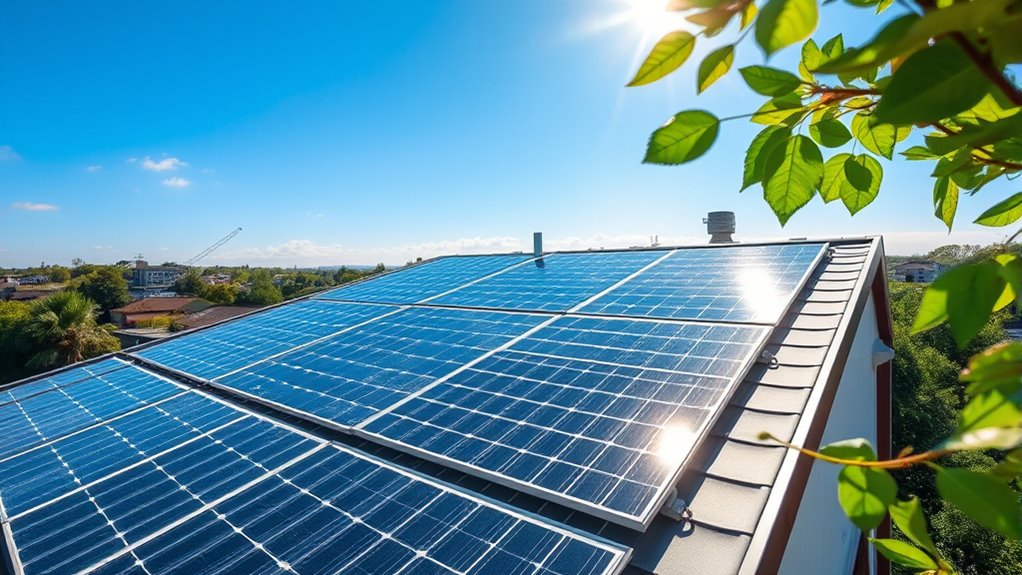
Installing solar panels at home offers numerous benefits that can considerably enhance your financial, environmental, and energy independence. One of the most immediate advantages is the potential to significantly lower your energy costs. Over the lifespan of your solar system, you could save between $31,000 and $100,000, with the average U.S. homeowner saving around $50,000 on electricity. These savings are especially impactful as electricity prices continue to rise, helping you lock in stable energy expenses and offset future increases. Depending on where you live, your energy consumption, and the size of your system, these savings can be substantial, providing long-term financial relief and making solar a smart investment.
Installing solar panels can save the average U.S. homeowner around $50,000 on electricity costs.
Beyond saving money, solar energy plays a pivotal role in protecting the environment. By harnessing the power of the sun, you reduce your carbon footprint and contribute to cleaner air. For example, in 2022, solar power offset over 140 million metric tons of CO2 emissions. Using solar panels supports efforts to combat climate change and promotes sustainable living by decreasing reliance on fossil fuels. Additionally, most solar panel components are recyclable—between 90% and 97%—which further reduces waste and environmental impact. Choosing solar aligns your home with eco-friendly practices, helping you make a positive difference for future generations.
Technological improvements continue to make solar installations more attractive. New innovations like advanced battery storage systems boost efficiency and allow you to store excess energy for later use, even during power outages. Smart grid technologies enhance how energy is managed and distributed, increasing your system’s reliability. Modern solar panels are now more durable and perform better, thanks to ongoing research and development. These advancements not only improve the efficiency of your system but also make solar solutions more cost-effective, encouraging wider adoption and making it easier for you to go solar.
Government incentives further elevate the appeal of solar energy. The Inflation Reduction Act offers a 30% tax credit for installation costs through 2032, substantially reducing your upfront expenses. Programs like Solar for All aim to make solar accessible to low-income households, ensuring that more people can benefit. These policies not only make solar more affordable but also stimulate industry growth, resulting in more options and better pricing for homeowners like you.
Installing solar panels can also boost your property’s value. Homes equipped with solar systems are viewed as more desirable and can command higher resale prices. The savings on energy costs serve as an attractive selling point, especially for environmentally conscious buyers. Moreover, solar energy provides you with greater energy independence. With battery storage, you can store excess power and reduce your reliance on the grid, gaining resilience during outages and customizing your energy needs.
As the solar industry continues to grow—projected to expand by 75% from 2023 to 2025 and install an average of 43 GW annually through 2029—you benefit from a stable and expanding market. Government policies and technological innovations are fueling this growth, making solar a reliable, forward-looking choice for homeowners seeking financial savings, environmental stewardship, and energy independence.
Frequently Asked Questions
How Long Do Solar Panels Typically Last?
Solar panels typically last around 25 to 35 years, but their actual lifespan depends on factors like climate, quality, and maintenance. You can expect them to retain most of their efficiency for the first 10-15 years, with some lasting even longer. Proper care helps extend their life, and after about 30 years, they might need replacement or upgrades to maintain peak energy production.
Are Solar Panels Effective in Cloudy Weather?
Did you know solar panels still generate up to 40% of their capacity on cloudy days? You’ll find that they remain effective even in less-than-sunny weather, thanks to diffuse sunlight penetrating clouds. Modern panels are designed to capture a broader spectrum, including infrared and ultraviolet light. So, while efficiency drops, you can still produce significant energy, making solar power a reliable option regardless of weather conditions.
What Is the Typical Installation Timeframe?
The typical installation timeframe for solar panels ranges from two to six months. You’ll start with an assessment, design, and permits, which can take up to two months. The actual installation usually happens within a few days, but weather and complexity can extend this. Afterward, inspections and utility approvals might add extra time. Planning ahead guarantees you meet deadlines for incentives and get your system operational as smoothly as possible.
Do Solar Panels Increase Home Insurance Costs?
Did you know that installing solar panels can lead to a slight increase in your home insurance premiums? When you add solar panels, you usually need to raise your coverage limits, especially for replacement costs, which can range from $15,000 to $25,000. While this might bump up your premiums, the increase is often small compared to the added home’s value and benefits, making it a worthwhile investment.
Can I Install Solar Panels Myself?
You can install solar panels yourself, but it’s not without challenges. You’ll need to plan carefully, understand electrical safety, and comply with local regulations. Installing the racking, inverter, and wiring requires technical knowledge and precision. While DIY can save money and give you a sense of accomplishment, mistakes can be dangerous or reduce efficiency. Consider your skills, safety, and available support before deciding to take on this complex project.
Conclusion
By installing solar panels at home, you’ll open a limitless energy source that could power your house for eternity, slash your electricity bills to zero, and make you a hero in the fight against climate change. Imagine never worrying about rising energy costs again and watching your home become a shining beacon of sustainability. It’s not just an upgrade; it’s a revolution that transforms your entire life into a bright, eco-friendly future—faster than you ever thought possible.

